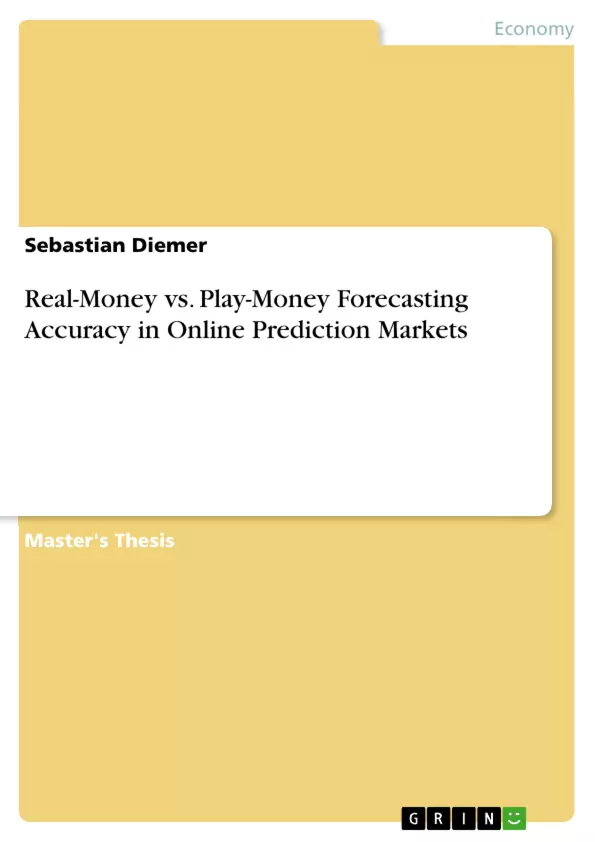Prediction markets are online trading platforms where contracts on future events are traded with payoffs being exclusively linked to event occurrence. Scientific research has shown that market prices of such contracts imply high forecasting accuracy through effective information aggregation of dispersed knowledge. This phenomenon is related to incentives for truthful aggregation in the form of real-money or play-money rewards. The question whether real- or play-money incentives enhance higher relative forecast accuracy has been addressed by previous works with diverse findings. The current state of empirical research in his field is subject to two inherent deficiencies. First, inter-market studies suffer from market disparities and differences in the definition of underlying events. Comparisons between two different platforms (one for play-money contracts, one for real-money contracts) are potentially biased by different trading behaviour. Second, the majority of studies are based upon identical datasets of market platforms (IOWA stock exchange, Tradesports/Intrade, NewsFutures).
This thesis contributes new insights by analysing 44,169 trading observations on ipredict, where real-money and play-money contracts are traded on a variety of events. Forecasting accuracy is analysed on overall trading activity as well as comparison of equal contracts under different monetary incentive schemes. Statistical models are built to analyse the influence of order volumes and days to expiry under both incentive schemes. Ignoring different events in underlying trading activity, play-money contracts imply statistically insignificant excess accuracy. In direct comparison of equal events, real-money contracts, however, real-money contracts predict at significantly higher accuracy. This thesis finds a relationship between order volumes and forecasting accuracy whereas the influence of days to expiry and aggregated volumes showed lower R² than was expected by formed hypotheses.
Inhaltsverzeichnis (Table of Contents)
- Introduction and Theoretical Fundamentals
- Introduction
- Definition of Prediction Markets
- Theoretical Framework
- Literature Overview
- Real-money vs. Play-money
- Other Factors With Influence on Forecasting Accuracy
- Closed Prediction Markets
- Data
- Data Provider
- Definition of Variables
- Results
- Overall Data
- Real-Money vs. Play-Money: Portfolio Comparison
- Real-Money vs. Play-Money: Direct Contract Comparison
- Real-Money/Play-Money: Influencing Factors
Zielsetzung und Themenschwerpunkte (Objectives and Key Themes)
This thesis explores the relationship between forecasting accuracy and different monetary incentive schemes in online prediction markets. The primary goal is to determine if real-money contracts consistently outperform play-money contracts in predicting future events. The research focuses on analyzing data from a novel dataset, ipredict.co.nz, which allows for a direct comparison of real-money and play-money contracts on the same platform.- Predictive accuracy of real-money vs. play-money contracts in online prediction markets.
- Analysis of forecasting performance across different types of events.
- The influence of order volumes and time to expiry on forecasting accuracy.
- Exploring the impact of different monetary incentive schemes on market behavior.
- Analyzing the aggregation of dispersed knowledge and its role in prediction market accuracy.
Zusammenfassung der Kapitel (Chapter Summaries)
The introduction presents the concept of prediction markets, highlighting the significance of information aggregation through monetary incentives. The theoretical framework outlines the mechanics of market pricing and its interpretation as probabilities of occurrence. Chapter 2 examines the literature on real-money vs. play-money incentives in prediction markets, summarizing findings from previous studies. It also discusses other factors impacting forecasting accuracy and explores the limitations of closed prediction markets. Chapter 3 introduces the dataset used in the study, defining the data provider and the key variables used in the analysis. Chapter 4 presents the results of the empirical analysis, examining overall data trends and comparing the predictive performance of real-money and play-money contracts.Schlüsselwörter (Keywords)
This thesis investigates the relationship between real-money and play-money incentives in online prediction markets. It explores the impact of different monetary schemes on forecasting accuracy, focusing on themes like information aggregation, crowd wisdom, and the role of order volumes and time to expiry in predicting future events. The study relies on data from ipredict.co.nz, a platform offering both real-money and play-money contracts, allowing for a direct comparison of these schemes.- Quote paper
- Bsc. Sebastian Diemer (Author), 2010, Real-Money vs. Play-Money Forecasting Accuracy in Online Prediction Markets, Munich, GRIN Verlag, https://www.grin.com/document/212468



